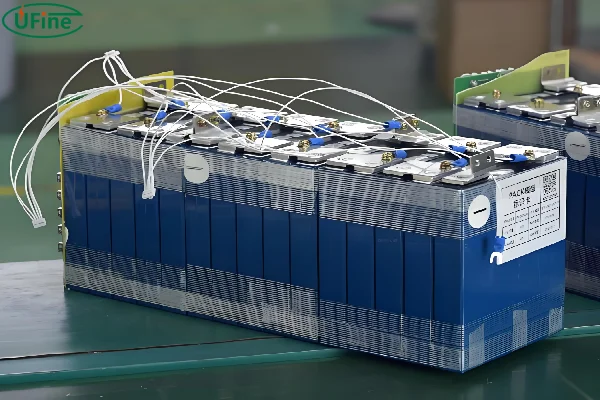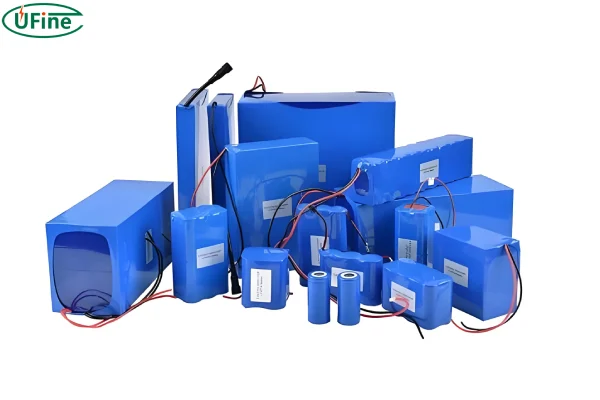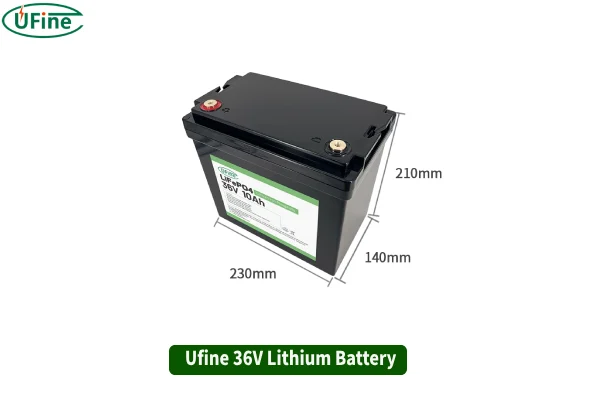Part 1. 36V battery types
When it comes to 36V batteries, you have several options to choose from. Each type has its own unique characteristics, chemistry, pros, and cons. Let’s break them down:
1.36V Lithium-Ion (Li-ion) Batteries
Characteristics:
Lithium-ion batteries are known for being lightweight and having a high energy density. This means they pack a lot of power relative to their size and weight.
Chemistry:
These batteries use lithium salts dissolved in organic solvents. The movement of lithium ions between the anode and cathode during charging and discharging is what generates power.
Pros:
- High Energy Density: You get more power in a smaller package.
- Lightweight: Ideal for portable applications.
- Long Lifespan: Typically lasts several years with proper care.
- Fast Charging: Reduces downtime significantly.
- Low Maintenance: No need for regular topping up of fluids.
Cons:
- Higher Cost: Higher upfront costs are more expensive compared to other types.
- Sensitivity: Can be affected by extreme temperatures and overcharging.
2. 36V Nickel Metal Hydride (NiMH) Batteries
Characteristics:
NiMH batteries offer a moderate energy density and are somewhat heavier than lithium-ion batteries.
Chemistry:
They use nickel oxide hydroxide and a hydrogen-absorbing alloy. The chemical reaction between these materials generates power.
Pros:
- Environmentally Friendly: Less toxic compared to other battery types.
- Cost-Effective: Generally cheaper than lithium-ion batteries.
- Good Performance: Reliable for moderate power needs.
Cons:
- Shorter Lifespan: It doesn’t last as long as lithium-ion.
- Slower Charging: It takes more time to recharge.
- Memory Effect: Can lose capacity over time if not fully discharged regularly.
3. 36V Sealed Lead Acid (SLA) Batteries
Characteristics:
SLA batteries are heavy and bulky, with a lower energy density.
Chemistry:
These batteries use lead dioxide and sulfuric acid. The chemical reaction between these substances produces electrical energy.
Pros:
- Low Cost: Very affordable compared to other types.
- Robust Design: Can withstand a lot of physical abuse.
- Reliable: Good for applications where weight is not a critical factor.
Cons:
- Heavy: Not suitable for portable applications.
- Shorter Lifespan: Needs to be replaced more frequently.
- Maintenance Required: Requires regular topping up of fluids.
Part 2. What is the difference between 36V and other voltage?
With batteries available in various voltages like 12V, 24V, and 48V, you might wonder why you should choose a 36V battery. Let’s explore why 36V batteries are often considered the best option for many applications.
1.Balance of Power and Weight
36V batteries offer an excellent balance of power and weight. They provide sufficient power for most mid-range applications without being too heavy or bulky. This makes them ideal for portable devices like electric bikes and scooters.
2. Versatility
36V batteries are versatile and can be used in a wide range of devices and applications. From power tools to marine equipment, their versatility makes them a popular choice.
3. Efficiency
36V batteries are highly efficient, providing ample power for most applications without the complexity of higher voltage systems. This efficiency translates to better performance and longer runtimes.
Comparison with Other Voltages
12V Batteries:
12V batteries are suitable for smaller devices and applications. However, they may not provide enough power for high-demand applications.
24V Batteries:
24V batteries are a middle ground but still less powerful than 36V batteries. They can be suitable for some applications but might fall short for more demanding uses.
48V Batteries:
48V batteries are more powerful but also heavier and more expensive. They are often overkill for many applications and come with added complexity.
At Ufine Battery, we understand that every application requires a specific battery solution. Our team is dedicated to providing products that offer maximum efficiency, safety, and performance for your needs. If you’re looking for a customized 36V battery or any other lithium battery, we invite you to contact us for more information.
Reach out to Ufine Battery today, and let’s discuss how we can assist with your project!
Part 3. 36v Li ion deep cycle battery vs. traditional lead acid battery
1. Lifespan
Unlike traditional 36V lead-acid batteries, which typically last around 500-1000 cycles, 36V lithium-ion deep cycle batteries offer a significantly longer lifespan of 2000-3000 cycles. This translates into less frequent replacements and better long-term value.
2. Maximum Charging Voltage
Lithium-ion batteries have a higher maximum charging voltage (42V) compared to lead-acid (typically 42V to 44V), allowing faster and more efficient charging while maintaining battery health.
3. Discharge Cut-off Voltage
A 36V lithium-ion battery generally has a discharge cut-off voltage of 30V, which is safer than traditional lead-acid batteries that often allow discharges down to 20V, leading to quicker degradation.
4. Maximum Charging and Discharge Current
Lithium-ion batteries support higher charging (up to 1C) and discharge currents (up to 2C) compared to lead-acid, which means they can deliver and store energy more efficiently, providing quicker power output.
5. Self-discharge
Lithium-ion batteries have a lower self-discharge rate (around 2-5% per month), compared to lead-acid batteries which lose around 10-15% of their charge each month, making them more reliable during long periods of inactivity.
6. Depth of Discharge (DOD)
Lithium-ion batteries can safely discharge up to 80% DOD, while lead-acid batteries typically last only if discharged up to 50% DOD. This allows for more usable capacity in lithium-ion designs.
7. Fast Charging
Unlike lead-acid, which requires slower charging times (often 8-12 hours), 36V lithium-ion batteries can support fast charging (80% in 1-2 hours), making them more convenient for high-demand applications.
8. Cold Weather Performance
Lithium-ion deep cycle batteries perform better in cold weather compared to lead-acid batteries, which struggle at temperatures below 0°C (32°F), suffering from reduced capacity and efficiency. Lithium-ion models offer improved performance and safety in low temperatures.
9. High Energy Density
Lithium-ion batteries offer high energy density, meaning they can store a lot of power in a small package. This is ideal for applications where space is limited, but power needs are high.
10. Lightweight:
Lithium-ion batteries are significantly lighter than their NiMH and SLA counterparts. This makes them easier to carry and install, which is especially important for portable applications.
Part 4. 36V battery mAh
The mAh (milliampere-hour) rating of a 36V battery tells you about its capacity. Essentially, it indicates how much energy the battery can store. The higher the mAh, the longer the battery can power your device.
For example, a 36V battery with 10,000 mAh (10 Ah) can last twice as long as one with 5,000 mAh (5 Ah) under the same conditions. This is crucial when choosing a battery because you want one that matches your device’s power needs and usage patterns.
Choosing the Right Capacity
When selecting a 36V battery, consider the device’s power consumption. Devices with higher power demands will drain the battery faster, so a higher mAh rating would be more beneficial. On the flip side, for devices with lower power needs, a lower mAh battery might suffice, saving you some money.
Part 5. Size and weight
The size and weight of 36V batteries can vary significantly based on the type and capacity. This is an important factor to consider, especially for portable applications like electric bikes or scooters.
1. Lithium-Ion Batteries
Lithium-ion batteries are generally the smallest and lightest of the three types. This makes them ideal for applications where weight and space are critical factors.
Example Size: A standard 10 Ah 36V lithium-ion battery might weigh around 10-15 lbs and be compact enough to fit into a small compartment.
2. Nickel Metal Hydride Batteries
NiMH batteries are bulkier and heavier than lithium-ion batteries. They are still usable in portable applications but might add a bit more weight.
Example Size: A similar capacity NiMH battery might weigh around 15-20 lbs and be slightly larger.
3. Sealed Lead Acid Batteries
SLA batteries are the heaviest and bulkiest. They are generally not suitable for portable applications but can be perfect for stationary uses where weight is not a concern.
Example Size: A 36V SLA battery might weigh 25-30 lbs or more, making it cumbersome to move around.
Size and Weight Considerations
When choosing a battery, always consider the physical constraints of the device you’re powering. For portable devices, lithium-ion batteries are usually the best choice due to their lightweight and compact size. For stationary applications, SLA batteries can be a cost-effective solution if weight is not an issue.
Part 6. How long does a 36 volt battery last?
The lifespan of a 36V battery depends on several factors, including the type of battery, usage patterns, and maintenance. Let’s explore how long you can expect different types of 36V batteries to last.
1. Lithium-Ion Batteries
Standard Lithium-Ion Battery:
A standard lithium-ion 36V battery typically lasts between 2-5 years. This translates to about 500-1,000 charge cycles under regular use conditions. Proper care, such as avoiding extreme temperatures and not overcharging, can extend the lifespan.
High-Quality Lithium-Ion Battery:
Higher quality lithium-ion batteries can last even longer, up to 5-7 years, or about 1,000-2,000 charge cycles. These batteries often come with advanced management systems to optimize performance and longevity.
2. Nickel Metal Hydride Batteries
NiMH batteries generally have a shorter lifespan compared to lithium-ion batteries. You can expect them to last around 1-3 years or about 300-500 charge cycles. Proper usage and regular full discharges can help maximize their lifespan.
3. Sealed Lead Acid Batteries
SLA batteries have the shortest lifespan among the three types. They typically last between 1-2 years or about 200-300 charge cycles. Regular maintenance, such as topping up fluids and avoiding deep discharges, is crucial to getting the most out of these batteries.
Factors Affecting Lifespan
- Several factors can impact the lifespan of your 36V battery:
- Usage Patterns: Frequent deep discharges can shorten battery life.
- Temperature: Extreme temperatures can degrade battery performance.
- Charging Practices: Overcharging or undercharging can harm the battery.
- Maintenance: Regular maintenance can extend the lifespan of NiMH and SLA batteries.
Part 7. What is a 36 volt battery used for?

36V batteries are incredibly versatile and find applications in a wide range of devices and scenarios. Here are some common uses:
Electric Bikes and Scooters
One of the most popular uses of 36V batteries is in electric bikes and scooters. The 36V battery provides enough power for efficient and long rides, making it a favorite among commuters and recreational riders alike.
Power Tools
36V batteries are also used in high-power tools that require consistent and reliable energy. Whether it’s a drill, a saw, or another power tool, a 36V battery ensures you have the power to get the job done.
Marine Applications
In the marine world, 36V batteries power trolling motors and other marine equipment. Their robust performance and reliability make them ideal for such demanding applications.
Solar Power Storage
36V batteries are used to store energy generated by solar panels. They can then release this stored energy when needed, making them essential for off-grid solar power systems.
Golf Cart
Golf carts also rely on 36V batteries for their power needs. These batteries provide the necessary energy to keep the carts running smoothly throughout the day.
Home Backup Systems
In some home backup systems, 36V batteries are used to store energy that can be used during power outages. This ensures that essential appliances and systems remain operational even when the grid goes down.
Related Tags:
More Articles

How to Choose the Best Floor Scrubber Battery for Commercial Cleaning?
Selecting the ideal floor scrubber battery ensures a long runtime, rapid charging, and minimal maintenance for efficient commercial cleaning operations.
Battery for Blower vs Battery for Leaf Vacuum: Which One Should You Choose?
Battery for blower vs leaf vacuum—learn the key differences in power, fit, and runtime to choose the right battery for your outdoor tool needs.
How to Choose the Right Battery for Blower?
Choosing the right blower battery? Consider voltage, capacity, chemistry & usage. This guide helps match the best battery for peak performance.
How to Choose the Best Insulated Battery Box for Lithium Batteries?
Choosing the Best Insulated Battery Box for Lithium Batteries? Discover key factors such as size, material, and safety for optimal protection and performance.
7 Critical Elements on a Lithium Battery Shipping Label
What must be on a lithium battery shipping label? Learn 7 key elements to ensure safety, legal compliance, and correct handling across all transport modes.





